Skip to comments.
Very Detailed Update on the Undersea Discoveries off Cuba (Includes Photos!).
The Morien Institute ^
| May 28 2002
| Dr Paul Weinzweig
Posted on 08/19/2002 6:52:42 PM PDT by vannrox
Exclusive Morien Institute interview with
- Dr Paul Weinzweig -
Advanced Digital Communications
Havana, Cuba
On May 28 2002 National Geographic News reported on the many recent discoveries underwater on the coastal shelves around the world. The story focussed on the recent discovery of megalithic ruins some 2,200 ft below sea level off the coast of Cuba, interviewing geologist, Manuel Iturralde, the Director of Research at Cuba's Natural History Museum. He is the Consulting Geologist for the Canadian exploration company, Advanced Digital Communications (ADC), based in Havana, Cuba, which discovered the megalithic formations
It has been suggested that what they have discovered in the Yucatan Channel could be the buildings and monuments of an early, unknown American civilization, which sank beneath the waves during some ancient cataclysm. As Ocean Engineer, Paulina Zelitsky, and the ADC crew are currently back on expedition with their research vessel, 'Ulises', Dr Paul Weinzweig, a partner in ADC with his wife, Paulina Zelitsky, kindly agreed to answer some of our questions when the Morien Institute contacted ADC in Cuba, June 3rd - 12th 2002 ...
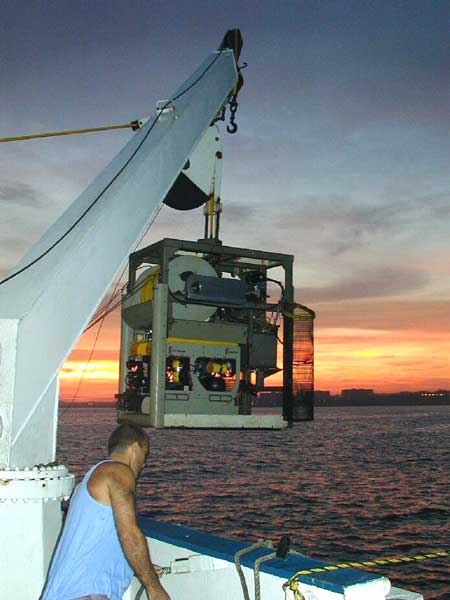
The ROV on the 'Ulises'research vessel
Advanced Digital Communications (ADC), based in Havana, Cuba, discovered the megalithic formations over the past two years using increasingly sophisticated equipment. The image directly below is of the winch that lowers and retrieves the Remotely-Operated-Vehicle (ROV) from the sea. It carries an array of lighting and video cameras. On this current expedition (June 2002) they have also taken a magnetometer to search for any metals which may be present amongst the megalithic ruins. Dr Paul Weinzweig told the Morien Institute on June 5th 2002 that:
"Presently (June 2002) the ship and team are conducting magnetometer, sidescan and ROV investigations of Cuban deep territorial waters in the Yucatan Channel"
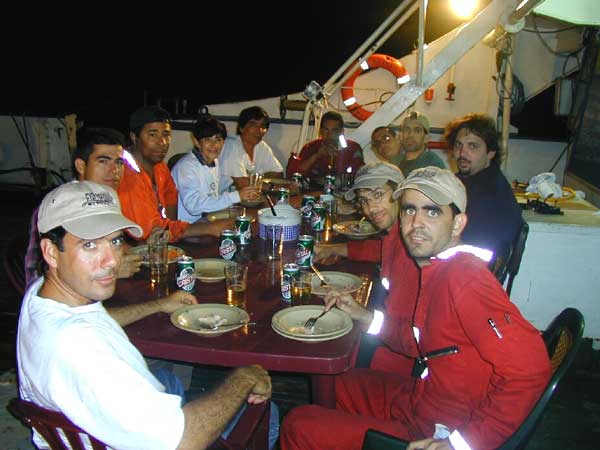
the ADC expedition crew eating their evening meal on board the 'Ulises' research ship. This is the time when they can relax, discuss the day's findings, and plan which part of the vast megalithic complex they should investigate next ...
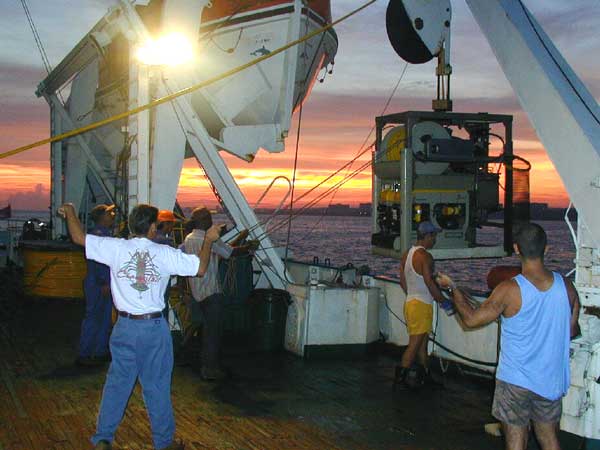
The ADC expedition crew winch the ROV aboard the 'Ulises' around sunset after a long day of deep water exploration in the Yucatan Channel
Morien Institute:
What is the ADC expedition team doing at this present time?
Dr Paul Weinzweig:
"Presently the ship and team are conducting magnetometer, sidescan and ROV investigations of Cuban deep territorial waters in the Yucatan Channel."
Morien Institute:
Are you currently looking for anything specific based on earlier findings, such as the carved symbols and hieroglyphs that were widely reported in the media over the last six months or so?
Dr Paul Weinzweig:
"I would not over-emphasize the earlier reports of symbols in rocks. At the time, water clarity and ROV lighting was not optimal. The currents in this particular area are very strong and there is a lot of backscatter light effects from current-driven plankton. Our next expedition to the site will try to improve the video quality with better lighting, low light cameras and some improved perspective shots of megalithic structures evidenced in our sidescan sonar images."
Morien Institute:
Will you attempt to take samples during the current expedition from the structures you have found, and what about samples of the sediments from around the structures?
Dr Paul Weinzweig:
"We have already taken a few samples this Spring which are presently being analyzed by our Consulting Geologist and Geophysicist, Dr. Manuel Iturralde, Director of Research for the Cuban Museum of Natural History. The samples include both mineral and biological."
a crew member taking samples whilst fixing the ROV on the deck of the 'Ulises' research vesse
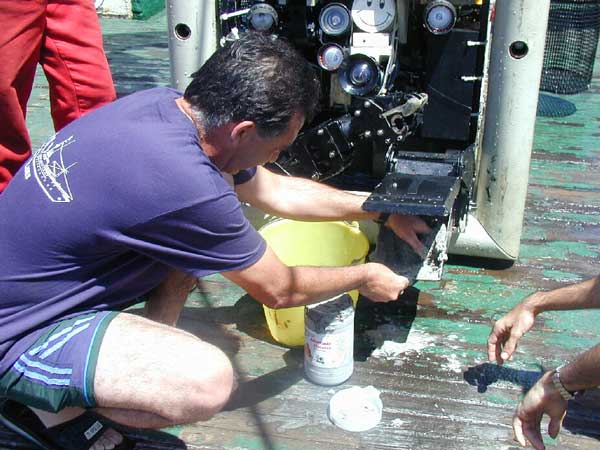
Ocean Engineer, Paulina Zeltisky, and other ADC crew members, examining some of the samples gathered by the ROV during one of it's expeditions in July 2001. The research ship 'Ulises' is equipped with sophisticated computers to help the ROV operators direct it to the most likely places to video the ruins ...
"To drill samples from these structures is not easy because they look like granite. And to drill granite at a depth of 600 metres is very difficult ... "
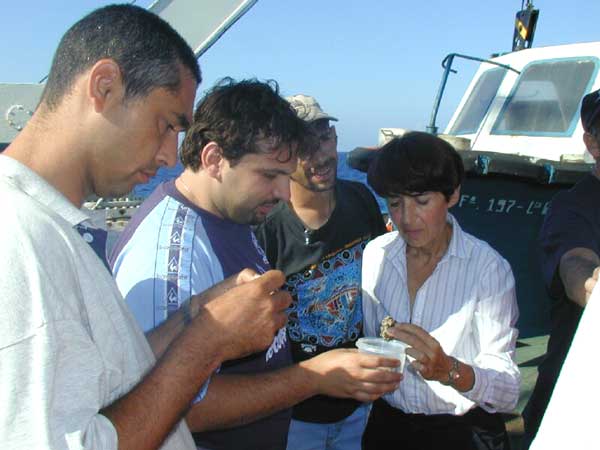
"We are discovering the influence of currents on global climate, volcanoes, the history of formation of Caribbean islands, numerous historic wrecks and even possibly a sunken city built in the pre-classic period and populated by an advanced civilization similar to the early Teotihuacan culture of Yucatan." Paulina Zelitsky, Whitley Streiber's Unknown Country", May 19 2001
Morien Institute:
What special equipment will you be using during the current expedition that you have not used before, and what extra data do you expect to be able to gather as a result?
Dr Paul Weinzweig:
"See the answer to question number 2 above. We may also try to re-do the sidescan sonar along with a powerful magnetometer to register any metals on the site."
Morien Institute:
I gather that there is another complex of apparent urban ruins, which has been discovered underwater in the Bay of Batabané, and that they stretch south towards the Isle of Youth. Has ADC explored these ruins, or if not, do you have any plans to explore them in the future?
Dr Paul Weinzweig:
"We have not explored these other areas yet but intend to in the future."
The ADC expedition crew with GeoPulse and winch aboard the 'Ulises' research vessel...
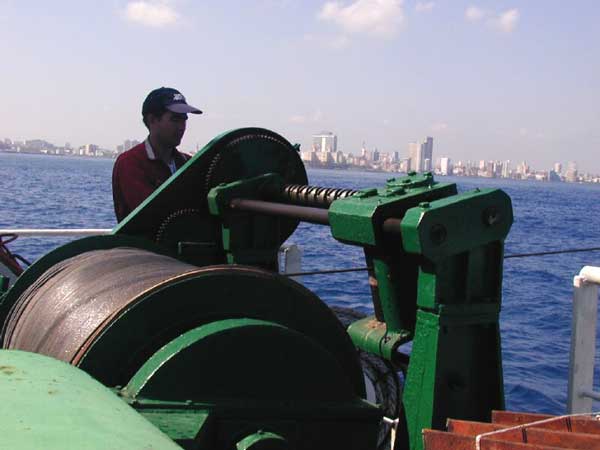
On December 7 2001 , Michael Posner of the Canadian Globe & Mail reported that in January 2002, the ADC expedition team would be returning to the site of the megalithic complex they discovered in July 2000, though this time with the first deep-water mobile excavator equipped with functions needed for on-site archæological evaluation, including the ability to blow sand off stone. In an interview with Dr Paul Weinzweig of ADC, Posner quoted Dr Weinzweig as saying:
"Some structures within the complex may be as long as 400 metres wide and as high as 40 metres ... Some are sitting on top of each other. They show very distinct shapes and symmetrical designs of a non-natural kind. We've shown them to scientists in Cuba, the U.S. and elsewhere, and nobody has suggested they are natural."
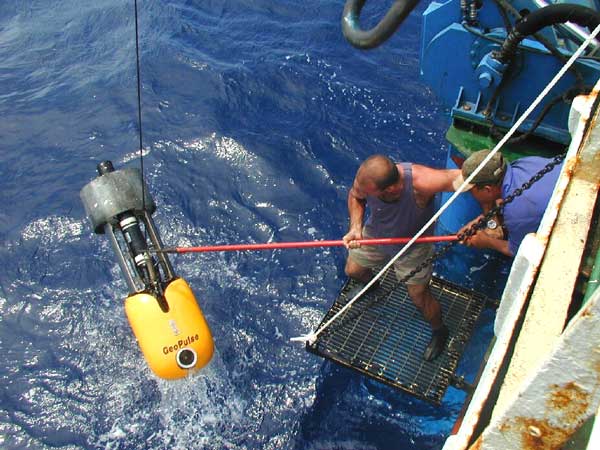
an ADC crew member helps to retrieve the GeoPulse Sidescan Sonar from the sea after an expedition in July 2001, when they returned with a 1.3 tonne, unmanned Remotely Operated Vehicle (ROV) controlled by fibre-optic cable from computers in the research ship 'Ulises'
The cameras on board the ROV confirmed the earlier findings, showing large granite-like blocks between 6 and 15 feet in length, that were cut in circular and perpendicular designs. But because of some technical problems encountered, Dr Weinzweig told the "Globe & Mail":
" ... we were only able to survey the perimeter of the site. Based on initial explorations, we think it's much larger than even our sonar projections show. It may extend for several kilometres."
Morien Institute:
There have been reports since the 1950's by light aircraft pilots of submerged buildings, evident from the air, to the north of Cuba and in the Old Bahaman Channel. Has ADC explored those ruins, and if not, do you have any plans to explore them in the future?
Dr Paul Weinzweig:
"Probably not. Since our work is currently confined to Cuba's deep territorial ocean waters. Ocean images recorded by aircraft would be in shallow waters accessible by human divers. Our expertise is in Deep Ocean Technology and investigation."
geologist Dr Manuel Iturralde of Cuba's Natural History Museum and archæologist Dr Gabino La Rosa of the Cuban Museum of Natural Sciences discuss ocean charts of the underwater megalith discovery area...
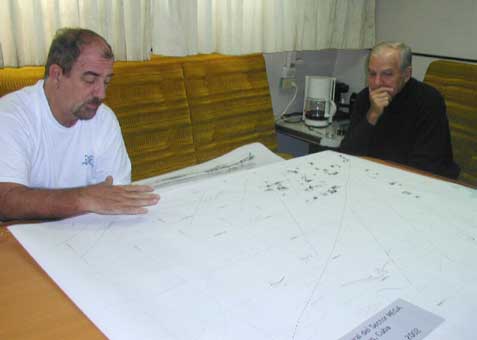
On May 28 2002 National Geographic News reported on the many recent discoveries underwater on the coastal shelves around the world. The story focussed on the recent discovery of megalithic ruins some 2,200 ft below sea level off the coast of Cuba, and made some interesting comments about ancient 'flood myths':
"Ancient stories of massive floods pass from generation to generation and in many places in the world are integral to a people's spoken history. The tales differ by locale, but commonly feature either torrential rains or a hugely destructive wall of water bursting into a valley, destroying everything in its path. In many cases, the flooding is an act of retribution by displeased gods. Scientists, historians, and archaeologists view many of these enduring tales as myth, legend, or allegoric tales meant to illustrate moral principles. Recent findings indicate that at least a few of them could be based on real floods that caused destruction on an enormous scale."
an ADC crew member operates the Sidescan Sonar while a colleague looks on. The images it sends back to the 'Ulises' are compared with the ocean charts of the area, and it seems that the plateau 2,200 ft down where the megalithic complex was discovered is right on the edge of a geological fault-line.
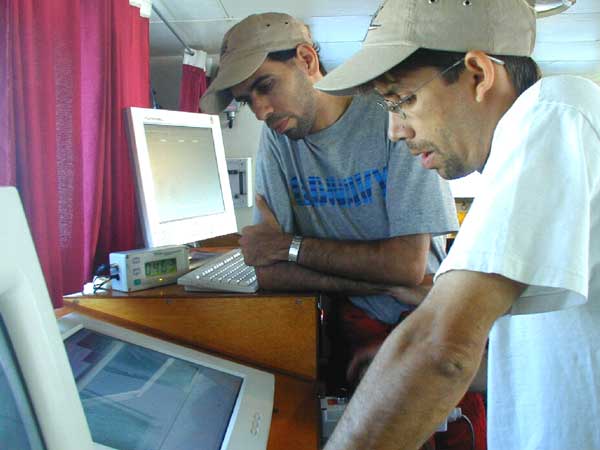
an ADC crew member 'flying' the ROV from the controls aboard the 'Ulises'. The remotely-operated-vehicle is attached to the ship by a fibre-optic cable, which allows the operator to navigate the Cuban deep territorial waters in the Yucatan Channel, where the megaliths were discovered in July 2000
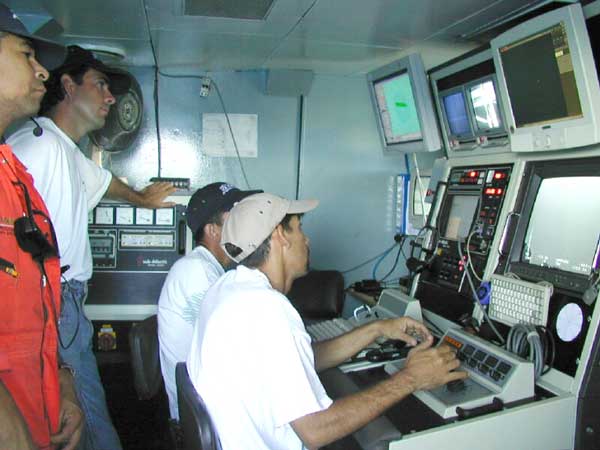
Morien Institute:
Do you have any thoughts about the recent discoveries of underwater megalithic structures in northwest India, at the Gulf of Cambay, and also in southeast India at Mahabalipuram?
Dr Paul Weinzweig:
"We follow these findings with interest. We believe that much of the significant archaeology of the future will be discovered in the little-explored world's oceans and will greatly expand our understanding of the enourmous antiquity of human civilization."
Morien Institute:
Similarly, do you have any thoughts about the underwater megalithic structures found off several of the Japanese islands, particularly the discovery at Yonaguni-Jima?"
Dr Paul Weinzweig:
"The marine structures at Yonaguni, as I understand them, bear close resemblance to the terraced terrestrial geology. Perhaps human settlements were carved out of local geology. In our Cuban site the granite monolithic stones are foriegn to the local marine and terrestrial geology."
On May 15 2001, ocean engineer, Paulina Zelitsky, of ADC was quoted in a Reuters despatch from Havana, Cuba:
"We don't know what it is and we don't have the videotaped evidence of this yet, but we do not believe that nature is capable of producing planned symmetrical architecture, unless it is a miracle, ... It is stunning. What we see in our high-resolution sonar images are limitless, rolling, white sand plains and, in the middle of this beautiful white sand, there are clear manmade large-size architectural designs. It looks like when you fly over an urban development in a plane and you see highways, tunnels and buildings ... "
Below, an ADC crew member is fixing the ROV on the deck of the 'Ulises' research vessel
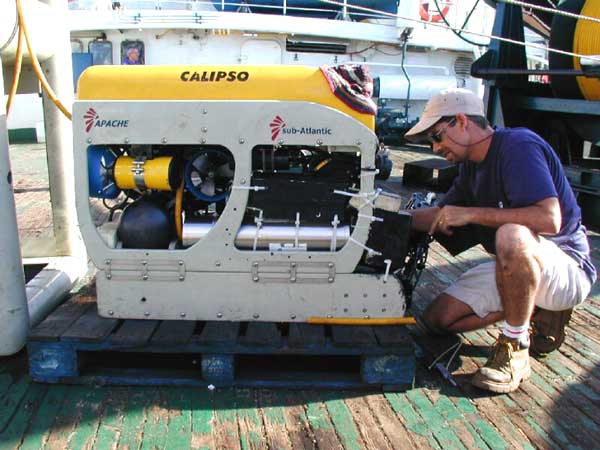
Below, the ADC expedition team are lowering the ROV back into the water after repairs. The ship is well-equipped for the task, and the crew have many years of experience between them in deep-water exploration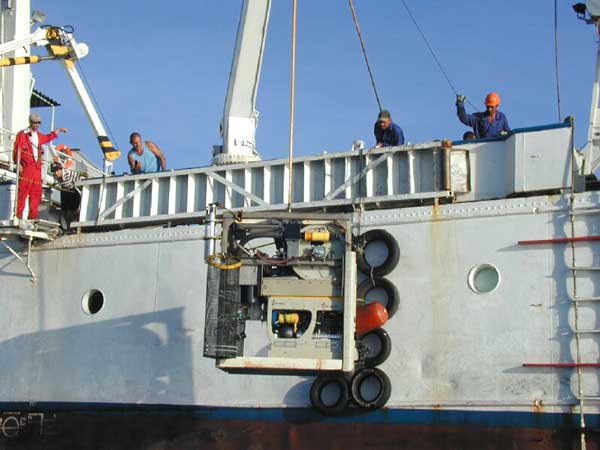
an ADC crew member at the controls of the ROV. Manoeuvring it precisely is a delicate operation, requiring intense concentration and a steady hand, but the GeoPulse equipment is just right for the job.
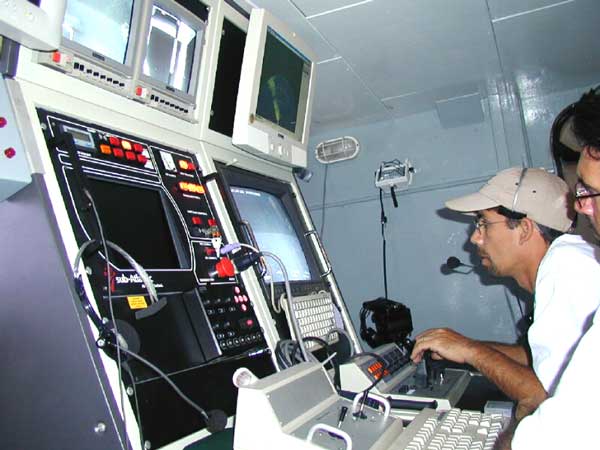
"It's a really wonderful structure which really looks like it could have been a large urban centre ... "
Paulina Zelitsky, BBC News, June 7 2001
Morien Institute:
Are the structures ADC has found off the Guanahacabibes Peninsula in western Cuba identical to ruins of the Mesoamerican 'Pre-Classic Period', or have you detected any unique features from the video footage ADC has acquired so far?
Dr Paul Weinzweig:
"At this stage in the investigations, we can only speculate that some features (such as temple foundations layouts) seem to be reproduced at our site. Since the ancients built their new structures on old structural sites, we really don't know their true antiquity. Garcilaso in "Royal Commentaries of the Incas" reports similar enormous geometrically shaped granite building stones in Cuzco (Peru) and Lake Titicaca.
These megalithic granite stones are located miles from the nearest quarries. There is nothing in our understanding of ancient engineering and construction or in our present rational imagination to explain the logistics of such megalithic construction. There is much mystery here."
Morien Institute:
We believe that similar symbols and hieroglyphs to what you have found carved on the underwater structures have also been discovered in various caves on the island of Cuba itself. Can you tell us anything about these discoveries on dry land?
Dr Paul Weinzweig:
"Yes, there are caves in the Isle of Youth and elsewhere that show ancient symbols. Andrew Collins, in "Gateway to Atlantis", examines some of these land sites and symbols."
Paulina Zelitsky of ADC looking at video from the ROV and the 'Sidescan Sonar' computer screen
On December 12 2001 the Cuban newspaper, "Granma" reported that during the previous summer, ADC had filmed ruins of a possible 'Lost City' submerged off the coast of the Guanahacabibes Peninsula, on the western tip of Cuba in the Yucatan Channel. It quoted ocean engineer, Paulina Zelitsky, of ADC as cautioning that the nature of their discovery is not yet fully understood, and that they would return in January 2002 to conduct further investigations:
"It's a marvelous structure which could possibly have been a great urban center ... However, it would be completely irresponsible to to say what it is, before having all the evidence."
An ADC crew member 'flying' the ROV from the controls on the 'Ulises' research vessel, with archæologist, Dr Gabino La Rosa, scrutinising the 'live' seabed video images sent back to the computer screen
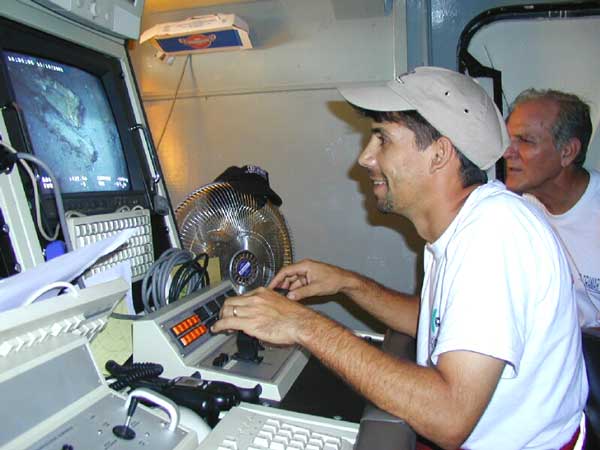
Below, Paulina Zelitsky of ADC looks at the video image of a 'pyramid-shaped structure' that the ROV had sent back to one of the dedicated computers on board the 'Ulises'. "Granma" reported that researchers have pointed out the mysterious structures could have been at least 6,000 years ago, 1,500 years before the first pyramids on the Giza plateau in Egypt. Paulina Zelitsky told them that the structures, presumably built on dry land before being covered by the sea, could have been sunk by volcanic activity in the area. It also told that, in July 2000, ADC researchers had identified an area 650 metres deep, where symmetrically organised stone structures that resembled an urban layout, were clearly visible:
,i>
"That footage confirms the presence of large blocks of granite in circular and perpendicular formations. Most of the blocks, between two and five meters long, were not covered. Others were covered with sediment and the area’s fine white sand."
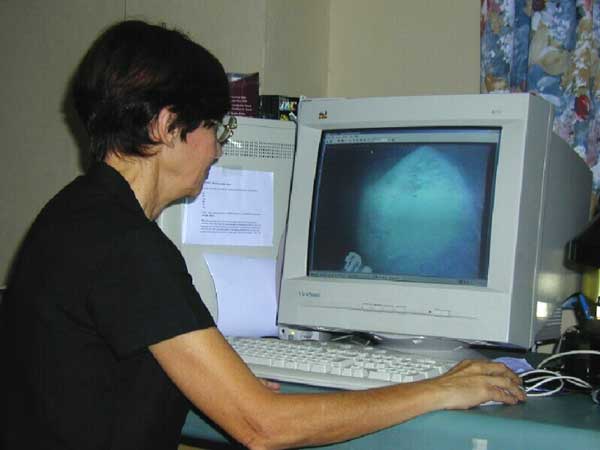
The computer screen below shows one of the original 'sidescan sonar' images from the July 2000 ADC expedition. On December 28 2001, a report by Reuters featured on Linda Moulton Howe's "Earthfiles" website, where Paulina Zelitsky was quoted as saying that ADC has high resolution sidescan sonar images of:
" ... a huge land plateau with clear images of what appears to be manmade large-size architechural designs partly covered by sand. From above, the shapes resemble pyramids, roads and buildings."
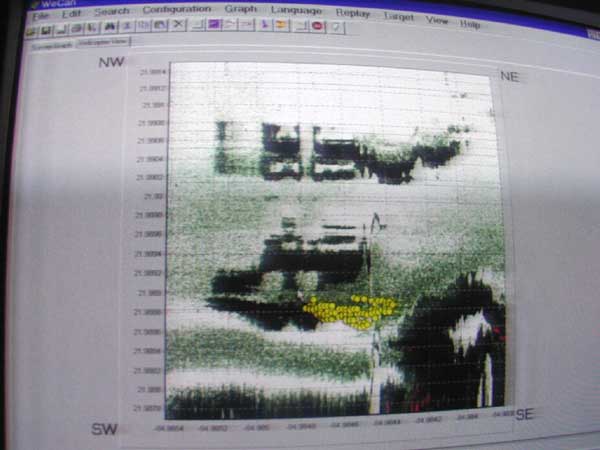
One of the many 'sidescan sonar' images of part of the megalithic complex discovered by ADC. Using a growing array of sophisticated underwater equipment, which includes the ROV, such images are facinating archæologists and geologists around the world. As ADC's investigations progress, it will be interesting to see if any of the roadways, or the axis orientation of any of the major structures, points in the direction of the 'Old North Pole', which during the last Ice Age was at 60° North, 73° West, in the Hudson's Bay area ...
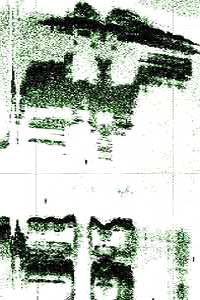
"We believe that much of the significant archaeology of the future will be discovered in the little-explored world's oceans and will greatly expand our understanding of the enormous antiquity of human civilization."
Dr Paul Weinzweig, June 12 2002, Havana, Cuba
Morien Institute:
Is there any geological evidence to suggest that the Caribbean Islands, as we see them today, might be just the mountain-tops and high ground of a much larger landmass which partially sank as a result of cataclysms in ancient times?
Dr Paul Weinzweig:
"Yes, geologists tell us that Yucatan, Cuba, Domincan Republic and Puerto Rico were connected at one time. There is still much to learn about the geological history of the Gulf of Mexico and the Caribbean. Our Consulting Geologist, Dr. Iturralde, is a world authority on the subject. You can find many references to his scientific work on the internet."
Dr. Weinzweig told us that Paulina Zelitsky and her crew aboard their research vessel 'Ulises' will be back on Cuban dry land at around the end of June 2002. We hope to have more images at that time, and to be able to provide an update on anything new that has been discovered during the current expedition
the location of the discoveries - an image link to the BBC story
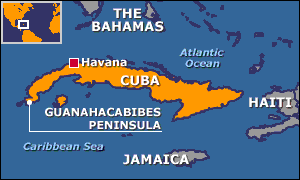
TOPICS: Business/Economy; Canada; Cuba; Culture/Society; Extended News; Foreign Affairs; Government; News/Current Events; Russia
KEYWORDS: atlantis; blocks; canada; catastrophism; cuba; explore; godsgravesglyphs; history; mystery; past; paulinazelitsky; paulinazelitzky; ruins; russia; science; stone; undersea; underwater; yonaguni
Navigation: use the links below to view more comments.
first previous 1-20, 21-24 last
21
posted on
03/13/2016 7:16:42 PM PDT
by
SunkenCiv
(Here's to the day the forensics people scrape what's left of Putin off the ceiling of his limo.)
Note: this topic is from 8/19/2002. Thanks vannrox.
22
posted on
03/13/2016 7:17:23 PM PDT
by
SunkenCiv
(Here's to the day the forensics people scrape what's left of Putin off the ceiling of his limo.)
To: SunkenCiv
This thread is now worthless without pictures.
23
posted on
03/13/2016 7:19:02 PM PDT
by
eastforker
(The only time you can be satisfied is when your all Trump.)
To: eastforker
The server runs slow, probably hasn’t had an update since the fall of Atlantis.
24
posted on
03/14/2016 2:58:09 AM PDT
by
SunkenCiv
(Here's to the day the forensics people scrape what's left of Putin off the ceiling of his limo.)
Navigation: use the links below to view more comments.
first previous 1-20, 21-24 last
Disclaimer:
Opinions posted on Free Republic are those of the individual
posters and do not necessarily represent the opinion of Free Republic or its
management. All materials posted herein are protected by copyright law and the
exemption for fair use of copyrighted works.
FreeRepublic.com is powered by software copyright 2000-2008 John Robinson



















